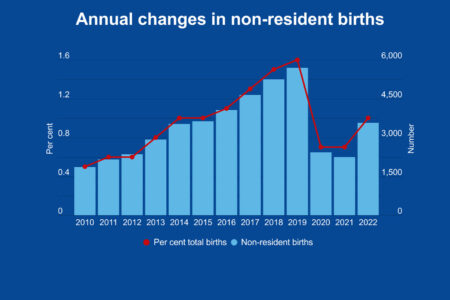
(Version française disponible ici)
The changing face of Canada and Quebec is leading to a transformation of the labour market. A growing proportion of the population comes from immigrant backgrounds and this trend will accelerate in the coming decades. Statistics Canada forecasts that immigrants and their Canadian-born children will make up nearly half the Canadian population by 2041, accounting for a significant share of the workforce.
While the vast majority of recently arrived immigrants belong to visible minorities, more and more people born here are from diverse backgrounds as well. StatsCan predicts that visible minorities could represent between 38 and 43 per cent of the total Canadian population by 2041.
Data from the 2021 census indicate that close to one in four young Québécois under the age of 25 is from a visible minority, a reality the labour market must now address.
Though the concept of an immigrant is clear, that of a visible minority is less so. Not all members of visible minorities are immigrants and not all immigrants are members of visible minorities, though for some years now the vast majority of recent immigrants (73 per cent in Quebec, 85 per cent in the rest of Canada) are members of a visible minority.
The term “visible minorities” refers to “persons, other than Aboriginal people, who are non-Caucasian in race or non-white in colour.” In Canada, Latino Americans, Chinese, Koreans, Japanese, Filipinos, South Asians, Southeast Asians, Western Asians as well as Blacks and Arabs are considered members of a visible minority. Hence, all individuals who emigrate from a Latin American country are deemed a visible minority, even those with white skin. In 2021 in Quebec, visible-minority members were mainly from three groups: Blacks (31 per cent), Arabs (21 per cent) and Latino Americans (13 per cent).
Major disparities in employment rates
Employment is an important indicator of integration. Many studies have looked into the circumstances of immigrants in the labour market, but the employment integration of people from diverse backgrounds, particularly of Canadian-born young people, is a much less documented phenomenon.
A study by CIRANO fills this gap using publicly available data from StatsCan’s Labour Force Survey and the 2021 census.
The findings are clear: belonging to a visible minority reduces the likelihood of finding employment. Visible-minority individuals born in Canada are the ones with the lowest employment rates, both among those in the 15-64 age group and those aged 15 to 24, as shown in Table 1. The results are qualitatively the same across Canada, with generally lower employment rates than in Quebec.
But more telling are the disparities once adjustments are made, namely the gaps that persist even when one cancels out the role of personal characteristics, other than belonging to a visible minority or having immigrant status, such as age, level of education, gender, attendance at an educational institution, province (for all of Canada), metropolitan area, and marital status. All gaps are statistically significant to 1%.
In Quebec, immigrants who are not members of a visible minority have employment rates that are lower by five percentage points than those of the reference group, all other factors being equal. This difference is even more pronounced for visible-minority immigrants, with employment rates lower by 9.4 percentage points.
Among young people between the ages of 15 and 24, the adjusted gaps are greater than for the overall 15-to-64 age group, even when controlling for differences in several personal characteristics, including school attendance. Thus, even if they were born in Canada, have a good command of French or English, and even if educated here, visible-minority youth appear to struggle to find a place in the labour market.
Visible minorities are not fairly compensated
We also examined the disparities in annual salary, both actually observed and adjusted, meaning the gaps that persist even after cancelling out the effect of several other factors that determine annual salary other than visible-minority or immigrant status.
As shown in Table 2, the adjusted disparities are very different from the observed disparities, reflecting the fact that the four groups do not share the same characteristics.
In the case of native-born individuals belonging to a visible minority, the gap with the reference group decreases from 26.9 per cent (observed) to nine per cent (adjusted). The 26.9 per cent gap means that, initially, native-borns belonging to a visible minority have characteristics unfavourable to them in terms of compensation compared to native-borns who are not part of a visible minority. The nine per cent gap after adjustment is problematic and signals integration difficulties for visible minorities, even if born in Canada.
As for visible-minority immigrants, the salary gaps compared to the reference group widen after adjustment, reaching nearly 24 per cent both in Canada and in Quebec.
The case of immigrants who are not part of a visible minority is unique because of the shift from a positive observed gap to a negative adjusted gap. At first glance, they are better paid than native-borns who are not part of a visible minority. However, after adjustment – and thus with equal characteristics – non-visible-minority immigrants earned on average 15.8 per cent less than native-borns not part of a visible minority.
These findings warrant further analysis to determine if these individuals’ experiences stem from discrimination or other non-observable factors that should be brought to light.
Taking action today to include the workers of tomorrow
More and more newcomers to the job market will be members of a visible minority. The case of young Canadian-born visible minorities merits special attention, with the goal of preventing their socioeconomic exclusion and the potential consequences for social cohesion.
In a context where Quebec and the rest of Canada rely on immigration to address the labour shortage, logic would dictate that we first realize the full potential of those already present. The integration into the workforce of Canadian-born individuals from ethnocultural minority groups, particularly the young, must be among the priorities of policymakers so as to avoid a situation where integration difficulties are passed on from one generation to the next. Failing this, a growing share of the population risks being marginalized.
Governments, the business community and all relevant stakeholders must work together on this in order to permanently eliminate the barriers hindering the economic integration of these young individuals and preventing them from fully contributing to the progress of society.










